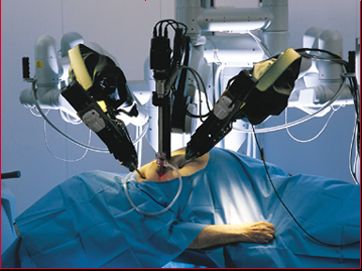


Precision robot arms maneuver microsurgical instruments through centimeter-long
holes into the heart of a cadaver in a demonstration of minimally invasive
surgery at Intuitive Surgical of Mountain View, California. Pencil-sized
robotic surgical instruments allow heart surgeons to perform operations
through a centimeter-long hole in the patient's chest. In a procedure
that greatly lessens the need to cut into tissue - thus reducing postoperative
pain and recovery time - doctors insert robotic instruments through minute
"ports" in the body. Instead of hovering over the operating
table, surgeons sit at a console a few feet - or, in theory, a continent
- away, controlling the roboscalpels with a pair of joysticklike grippers.
Each tool has a patented EndoWrist mechanism that allows it to move with
the dexterity and precision of the human hand. The whole ensemble - console,
tools, and operating table - was developed by the Stanford Research Institute,
a nonprofit R & D center created by Stanford University. The system
was commercialized by Intuitive Surgical; it now costs about $1 milliion.
The da Vinci surgical system, as it is called, is now in use in Europe;
although the da Vinci system has not yet been approved by the Food and
Drug Administration, the first, experimental remote-control bypass in
the United States took place in September 1999.
Origin
of Name
Leonardo da Vinci, who was a scientist and an artist
- just like many great surgeons who must reconstruct anatomy post-disease
or injury
Purpose
To perform more precise, less invasive surgery
Vision
3-D stereo
Computers
Our own - based on 4 Shark processors
Funding
Mayfield Fund, Morgan Stanley, Sierra Ventures,
other private investors
Project Status
Complete - 11 systems installed (9 in Europe, 2
in the U.S.)
Information Source
Sheila Shah


